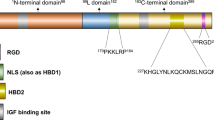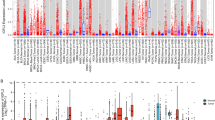Abstract
Insulin-like growth factor-binding protein 7 (IGFBP7) is a secreted protein involved in several cellular processes, including proliferation, senescence and apoptosis. Loss of IGFBP7 expression is a critical step in the development of human tumors, including melanoma and colon cancer. By microarray gene expression studies, we have detected downregulation of IGFBP7 gene expression in follicular and papillary thyroid tumors in comparison with normal thyroid tissue. Evaluation of publicly available PTC microarray gene expression data sets confirmed, in a consistent fraction of tumors, the downregulation of IGFBP7 transcript levels. The functional consequence of IGFBP7 downregulation was addressed in the PTC-derived NIM1 cell line in which IGFBP7 expression is repressed by promoter hypermethylation. Exposure to soluble IGFBP7 protein or restoration of IGFBP7 expression by complementary DNA transfection reduced growth rate, migration, anchorage-independent growth and tumorigenicity of NIM1 cells. We show that the effects of IGFBP7 are related to apoptosis. Our data suggest that loss of IGFBP7 expression has a functional role in thyroid carcinogenesis, and it may represent a possible basis for therapeutic strategies.
This is a preview of subscription content, access via your institution
Access options
Subscribe to this journal
Receive 50 print issues and online access
$259.00 per year
only $5.18 per issue
Buy this article
- Purchase on Springer Link
- Instant access to full article PDF
Prices may be subject to local taxes which are calculated during checkout







Similar content being viewed by others
References
Ahmed S, Yamamoto K, Sato Y, Ogawa T, Herrmann A, Higashi S et al. (2003). Proteolytic processing of IGFBP-related protein-1 (TAF/angiomodulin/mac25) modulates its biological activity. Biochem Biophys Res Commun 310: 612–618.
Akaogi K, Okabe Y, Sato J, Nagashima Y, Yasumitsu H, Sugahara K et al. (1996). Specific accumulation of tumor-derived adhesion factor in tumor blood vessels and in capillary tube-like structures of cultured vascular endothelial cells. Proc Natl Acad Sci USA 93: 8384–8389.
Aldred MA, Huang Y, Liyanarachchi S, Pellegata NS, Gimm O, Jhiang S et al. (2004). Papillary and follicular thyroid carcinomas show distinctly different microarray expression profiles and can be distinguished by a minimum of five genes. J Clin Oncol 22: 3531–3539.
Burger AM, Leyland-Jones B, Banerjee K, Spyropoulos DD, Seth AK . (2005). Essential roles of IGBP-3 and IGFBP-rP1 in breast cancer. Eur J Cancer 41: 1515–1527.
Chen Y, Pacyna-Gengelbach M, Ye F, Knosel T, Lund P, Deutschmann N et al. (2007). Insulin-like growth factor binding protein-related protein 1 (IGFBP-rP1) has potential tumour-suppressive activity in human lung cancer. J Pathol 211: 431–438.
Davies L, Welch HG . (2006). Increasing incidence of thyroid cancer in the United States, 1973–2002. JAMA 295: 2164–2167.
Ferrario C, Lavagni P, Gariboldi M, Miranda C, Losa M, Cleris L et al. (2008). Metallothionein 1G acts as an oncosupressor in papillary thyroid carcinoma. Lab Invest 88: 474–481.
Giordano TJ, Kuick R, Thomas DG, Misek DE, Vinco M, Sanders D et al. (2005). Molecular classification of papillary thyroid carcinoma: distinct BRAF, RAS, and RET/PTC mutation-specific gene expression profiles discovered by DNA microarray analysis. Oncogene 24: 6646–6656.
Greco A, Borrello MG, Miranda C, Degl′Innocenti D, Pierotti MA . (2009). Molecular pathology of differentiated thyroid cancer. Q J Nucl Med Mol Imaging 53: 440–453.
He H, Jazdzewski K, Li W, Liyanarachchi S, Nagy R, Volinia S et al. (2005). The role of microRNA genes in papillary thyroid carcinoma. Proc Natl Acad Sci USA 102: 19075–19080.
Hinoue T, Weisenberger DJ, Pan F, Campan M, Kim M, Young J et al. (2009). Analysis of the association between CIMP and BRAF in colorectal cancer by DNA methylation profiling. PLoS One 4: e8357.
Huang Y, Prasad M, Lemon WJ, Hampel H, Wright FA, Kornacker K et al. (2001). Gene expression in papillary thyroid carcinoma reveals highly consistent profiles. Proc Natl Acad Sci USA 98: 15044–15049.
Jarzab B, Wiench M, Fujarewicz K, Simek K, Jarzab M, Oczko-Wojciechowska M et al. (2005). Gene expression profile of papillary thyroid cancer: sources of variability and diagnostic implications. Cancer Res 65: 1587–1597.
Kanemitsu N, Kato MV, Miki T, Komatsu S, Okazaki Y, Hayashizaki Y et al. (2000). Characterization of the promoter of the murine mac25 gene. Biochem Biophys Res Commun 279: 251–257.
Latini FR, Hemerly JP, Oler G, Riggins GJ, Cerutti JM . (2008). Re-expression of ABI3-binding protein suppresses thyroid tumor growth by promoting senescence and inhibiting invasion. Endocr Relat Cancer 15: 787–799.
Lin J, Lai M, Huang Q, Ma Y, Cui J, Ruan W . (2007). Methylation patterns of IGFBP7 in colon cancer cell lines are associated with levels of gene expression. J Pathol 212: 83–90.
Lowe SW, Cepero E, Evan G . (2004). Intrinsic tumour suppression. Nature 432: 307–315.
Pallante P, Federico A, Berlingieri MT, Bianco M, Ferraro A, Forzati F et al. (2008). Loss of the CBX7 gene expression correlates with a highly malignant phenotype in thyroid cancer. Cancer Res 68: 6770–6778.
Ruan W, Xu E, Xu F, Ma Y, Deng H, Huang Q et al. (2007). IGFBP7 plays a potential tumor suppressor role in colorectal carcinogenesis. Cancer Biol Ther 6: 354–359.
Ruan WJ, Lin J, Xu EP, Xu FY, Ma Y, Deng H et al. (2006). IGFBP7 plays a potential tumor suppressor role against colorectal carcinogenesis with its expression associated with DNA hypomethylation of exon 1. J Zhejiang Univ Sci B 7: 929–932.
Sato Y, Chen Z, Miyazaki K . (2007). Strong suppression of tumor growth by insulin-like growth factor-binding protein-related protein 1/tumor-derived cell adhesion factor/mac25. Cancer Sci 98: 1055–1063.
Schrama D, Kneitz H, Willmes C, Adam C, Houben R, Becker JC . (2010). Lack of correlation between IGFBP7 expression and BRAF mutational status in melanoma. J Invest Dermatol 130: 897.
Sprenger CC, Damon SE, Hwa V, Rosenfeld RG, Plymate SR . (1999). Insulin-like growth factor binding protein-related protein 1 (IGFBP-rP1) is a potential tumor suppressor protein for prostate cancer. Cancer Res 59: 2370–2375.
Suzuki H, Igarashi S, Nojima M, Maruyama R, Yamamoto E, Kai M et al. (2010). IGFBP7 is a p53-responsive gene specifically silenced in colorectal cancer with CpG island methylator phenotype. Carcinogenesis 31: 342–349.
UK Coordinating Committee on Cancer Research (1988). UKCCCR guide lines for the welfare of animals in experimental neoplasia. Br J Cancer 58: 109–113.
Vasko V, Espinosa AV, Scouten W, He H, Auer H, Liyanarachchi S et al. (2007). Gene expression and functional evidence of epithelial-to-mesenchymal transition in papillary thyroid carcinoma invasion. Proc Natl Acad Sci USA 104: 2803–2808.
Wajapeyee N, Kapoor V, Mahalingam M, Green MR . (2009). Efficacy of IGFBP7 for treatment of metastatic melanoma and other cancers in mouse models and human cell lines. Mol Cancer Ther 8: 3009–3014.
Wajapeyee N, Serra RW, Zhu X, Mahalingam M, Green MR . (2008). Oncogenic BRAF induces senescence and apoptosis through pathways mediated by the secreted protein IGFBP7. Cell 132: 363–374.
Wilson HM, Birnbaum RS, Poot M, Quinn LS, Swisshelm K . (2002). Insulin-like growth factor binding protein-related protein 1 inhibits proliferation of MCF-7 breast cancer cells via a senescence-like mechanism. Cell Growth Differ 13: 205–213.
Yamanaka Y, Wilson EM, Rosenfeld RG, Oh Y . (1997). Inhibition of insulin receptor activation by insulin-like growth factor binding proteins. J Biol Chem 272: 30729–30734.
Zeki K, Nakano Y, Inokuchi N, Watanabe K, Morimoto I, Yamashita U et al. (1993). Autocrine stimulation of interleukin-1 in the growth of human thyroid carcinoma cell line NIM 1. J Clin Endocrinol Metab 76: 127–133.
Acknowledgements
The authors thank Mrs Sonia Pagliardini for technical assistance and Mrs Cristina Mazzadi for editing and secretarial help. This work was supported by AIRC grant N.4472, ACC and Ministry of Health.
Author information
Authors and Affiliations
Corresponding author
Ethics declarations
Competing interests
The authors declare no conflict of interest.
Rights and permissions
About this article
Cite this article
Vizioli, M., Sensi, M., Miranda, C. et al. IGFBP7: an oncosuppressor gene in thyroid carcinogenesis. Oncogene 29, 3835–3844 (2010). https://doi.org/10.1038/onc.2010.136
Received:
Revised:
Accepted:
Published:
Issue Date:
DOI: https://doi.org/10.1038/onc.2010.136
Keywords
This article is cited by
-
Cancer-associated fibroblast-secreted IGFBP7 promotes gastric cancer by enhancing tumor associated macrophage infiltration via FGF2/FGFR1/PI3K/AKT axis
Cell Death Discovery (2023)
-
Insulin like growth factor binding protein 7 (IGFBP7) expression is linked to poor prognosis but may protect from bone disease in multiple myeloma
Journal of Hematology & Oncology (2015)
-
Inhibition of IGF1-R overcomes IGFBP7-induced chemotherapy resistance in T-ALL
BMC Cancer (2015)
-
IGFBP-rP1 suppresses epithelial–mesenchymal transition and metastasis in colorectal cancer
Cell Death & Disease (2015)
-
Serum IGFBP7 levels associate with insulin resistance and the risk of metabolic syndrome in a Chinese population
Scientific Reports (2015)



